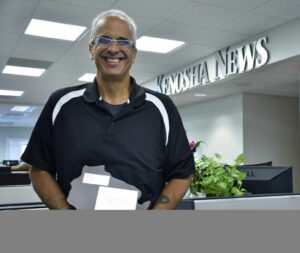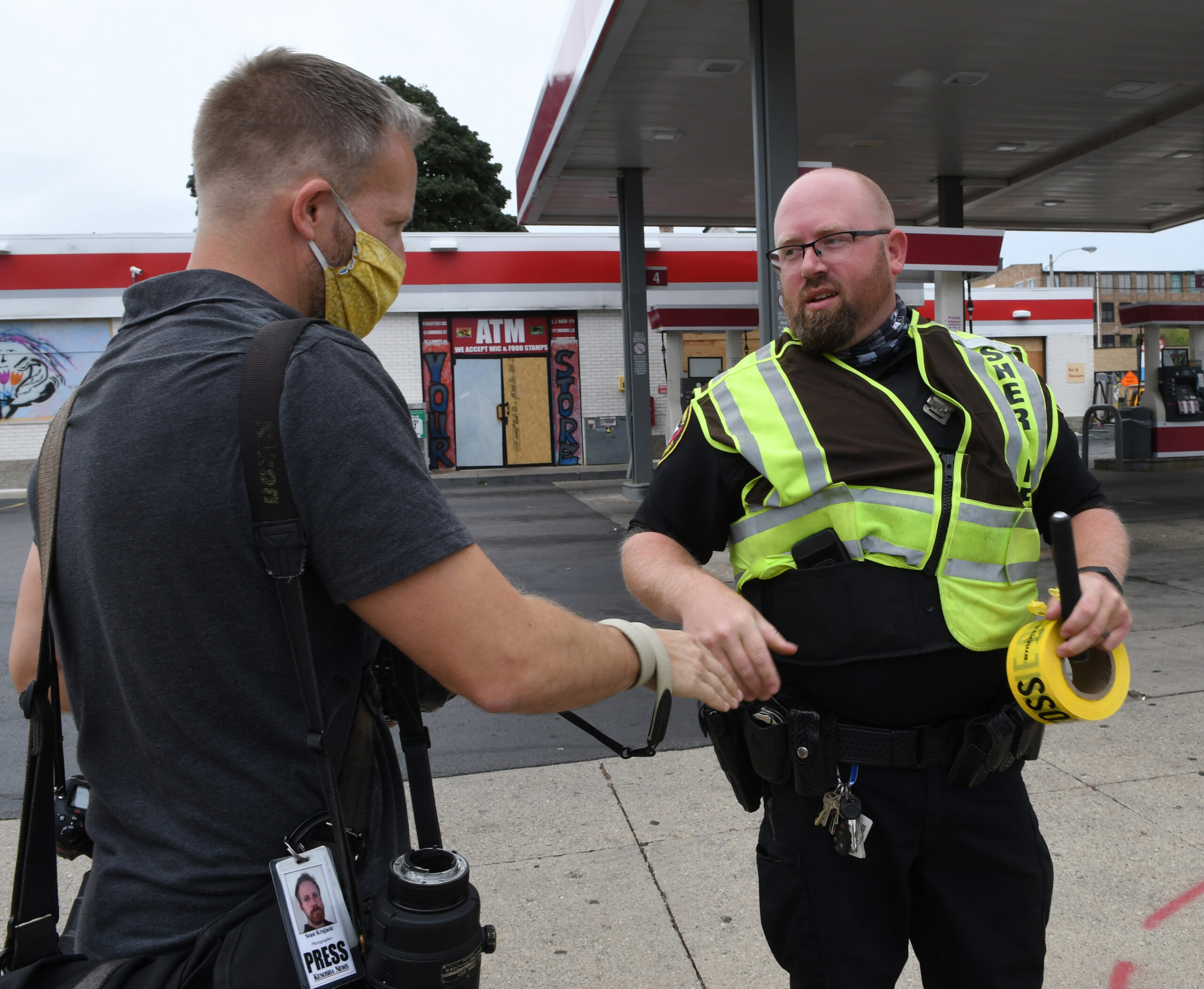But when community members gathered for a prayer service on the shores of Lake Michigan a few days after Blake was shot, the only reporter present was from the local paper, the Kenosha News.
The Washington Post, CNN and most of the other out-of-town media have left the town of 100,000 people, at least for now, and aren’t likely to return until there’s a decision on whether to charge any of the police officers involved in the shooting.
In the meantime, the News has remained a steady presence and has continued to provide daily coverage of a national news story that has deeply shaken its community. Kenosha News editorials have called on local officials to take a more active role in a solution, and the paper called for the collection of more local statistics on racial disparities in arrests, charges and sentences.
The paper has published frequent updates on the community “listening sessions” and other efforts at racial conciliation — a process that will last months, if not years, after national media have moved on to the next flashpoint in the national conversation about race and policing.

“We cover things that the national media are not going to cover,” said Dan Truttschel, a Kenosha News reporter. “We publish seven days a week, and we know everybody. We have a real feeling for the community.”
Local connections, local coverage, of a national story
Truttschel had special praise for Sean Krajacic, the paper’s only full-time photojournalist. Krajacic’s ability to capture emotion and perspective shined through, especially during difficult conditions at late-night protest rallies, he said.
“He’s fearless,” Truttschel said.
Krajacic’s 19 years at the paper allowed him to identify a local man — a barber, activist and youth mentor — to focus on during the first night of protests. The man was among the first to encounter tear gas deployed by law enforcement.
“Since I’ve photographed and spoken with him in the past, I was able to pick him out of the crowd at a very chaotic time and make photographs of him holding his eyes in one hand and clutching his coffee in the other,” Krajacic said. “He was, and is, delivering a peaceful message.
“When the regional and national media are gone, I will be the one to cover a lot of the folks who will continue to deliver their messages in this community,” Krajacic said.
Long hours for a small staff on a big story
Dodging flying bricks and trying to avoid whiffs of pepper spray, Kenosha News journalists escaped serious injury during the protests after the Blake shooting. But the small staff of the Lee Enterprises newspaper has been emotionally shaken by the ongoing turmoil associated with Kenosha’s version of the nationwide unrest over alleged police brutality against Black people.
The staff remained committed to informing the public, Truttschel said.
“It’s such a big story that we got dropped smack dab in the middle of,” he said. “The whole world is watching Kenosha.”
Police shot Blake outside a home after responding to a call about a domestic disturbance there. The wounds left Blake paralyzed from the waist down.
At the time of the shooting, there was a warrant for Blake’s arrest on Kenosha County charges of felony sexual assault against a woman, misdemeanor trespassing and disorderly conduct in connection with a previous incident. The New York Times reported that the woman who filed a criminal complaint that led to the charges and warrant was the person who called 911 and said Blake was at her home shortly before the shooting.
The shooting, videos of which were captured on bystanders’ cell phones, led to protests that caused millions of dollars in property damage. During one of the protests, Kyle Rittenhouse, 17, allegedly shot three people, two of them fatally, with a military-style, semi-automatic rifle after traveling to Kenosha from his home in suburban Chicago.
The shooting was shocking enough to the Kenosha News staff, Truttschel said. But covering the protests, killings and later visits by former Vice President Joe Biden and by President Donald Trump, who has commented little about the fatalities and declined to speak with Blake’s family, piled on additional stress.
“I told someone that I feel like I’m in the middle of a ‘Twilight Zone’ episode,” Truttschel said. “You don’t expect that in Kenosha.”
A shrinking newsroom, doing more with less
The newsroom staff of about a dozen journalists was stretched yet proud of what it was able to accomplish, especially in the week after the initial incident, he said.
“I think our coverage has been fantastic,” he said. “It’s long days and a lot of long nights.”
Everyone on the staff, including eight NewsGuild-represented journalists and a handful of editors, participated in the coverage, including the sports editor, who streamed rallies on Facebook Live, and executive editor Bob Heise, who updated the morning paper’s website past midnight after the print edition’s 7:40 p.m. deadline.
The early deadlines, the result of cost-cutting moves made in recent years, were a source of frustration for staffers covering the fallout of the Blake shooting. The Kenosha News for years was designed and printed in Kenosha. The paper now is laid out at a Lee regional design hub in Madison, Wisconsin, and print copies have to be trucked to Kenosha from a Lee printing plant 95 miles to the south, in Munster, Indiana.
The newsroom staff, numbering about two dozen as recently as 2016, has shrunken to 11 after rounds of buyouts, layoffs and attrition. Remaining are three editors and the eight Guild-represented workers (six full-time and two part-time.)
Covering the COVID-19 pandemic was hard enough with a reduced staff, and then the Blake shooting happened, Truttschel said.
While web hits to the paper’s website have skyrocketed, reaction from readers to the coverage has varied in the politically and racially charged aftermath of the shooting, he said.
Representatives from area chapters of the National Association for the Advancement of Colored People and Black Lives Matter didn’t return calls seeking comment.
The News itself became the topic of national news coverage, when the paper’s only full-time Black journalist — former digital and metro editor Daniel Thompson, who describes himself on Twitter as Black and Caucasian — resigned in the week after Blake’s shooting.
Thompson said on his Facebook page that he resigned over the paper’s initial refusal to change what he described as an inflammatory headline over an online story about a rally after Blake’s shooting. The headline was changed after Thompson quit.
Many Kenosha News staff members have lived in Kenosha for decades and set down roots there, Truttschel said. Even though Truttschel is a relative newcomer, he coaches girls softball at a local high school in his free time.
On one of his days off a few days after the Blake shooting, he took it upon himself to bring a shovel and broom to one of the areas damaged in the protests. He voluntarily helped with the cleanup.
Dean Olsen can be reached at (217) 836-1068 or olsen60@gmail.com.
Photo at top: Photographer Sean Krajacic on Sept. 2, the day of Trump’s visit in the wake of protests. Photo courtesy of Mark Hertzberg/ZUMA Press Wire.

